teodor
National Hazard
   
Posts: 872
Registered: 28-6-2019
Location: Heerenveen
Member Is Offline
|
|
The reaction of chlorosulfonic acid with different metals
While Lion850, vano and some other people do tremendous work of generating series of salts in water solutions I continue my weird experiments in the
water-free environment and last weekend the bottle of HSO3Cl was opened for this purpose.
There are not so many reactions with metals that are described in the literature available for me. Those few which are described are quite
interesting, like this one:
Sn + 4HSO3Cl -> SnCl4 + H2SO4 + 2SO2
I studied reaction with Cr, Co and Sn using dichloromethane as a solvent. I noticed that high concentrations cause passivation (e.g., Co). I remember
I read something that pyridine can be also used as a solvent in some cases but I am not sure, have to check .
What is interesting, I didn't get any usual color of Co(II) by reacting the acid with Co. The solution turned brown in all my experiments.
So, have you some information about how this acid should react with different metals?
[Edited on 20-9-2021 by teodor]
[Edited on 20-9-2021 by teodor]
|
|
|
Bedlasky
International Hazard
    
Posts: 1219
Registered: 15-4-2019
Location: Period 5, group 6
Member Is Offline
Mood: Volatile
|
|
https://woelen.homescience.net/science/chem/exps/HSO3Cl/inde...
|
|
|
teodor
National Hazard
   
Posts: 872
Registered: 28-6-2019
Location: Heerenveen
Member Is Offline
|
|
Thanks, I saw this Woelen & Bedlasky. Also, I have some information about the reactions of HSO3Cl with metal oxides. But what I mean is the
reactions of the acid with shiny metals in oxidation state 0, just bare metals. Especially the cases when the metal is not oxidized by HCl or H2SO4.
But also transition metals that coordinate water. I think the chlorosulfonic acid should be closer by action to HNO3 because it is also an oxidizer.
The most troublesome point is to find a solvent that doesn't react with this acid. Because, as I said, I suspect the passivation effect at high
concentrations.
Also, I failed a bit with corks. All-glass equipment is recommended.
And yes, Woelen's reaction with permanganate and dichromate is nice and well-demonstrated and documented.
[Edited on 21-9-2021 by teodor]
|
|
|
woelen
Super Administrator
        
Posts: 7977
Registered: 20-8-2005
Location: Netherlands
Member Is Offline
Mood: interested
|
|
The brown color you get in all your experiments with a solvent may be due to charring of some impurity in the solvent. My own experiency with
chlorosulfonic acid is that it chars nearly every organic, which is somewhat more complicated. Even really tiny amounts of impurities, which are
charred lead to brown colors. A similar experience I had with oleum, which also always leads to brown colors in combination with organics.
|
|
|
draculic acid69
International Hazard
    
Posts: 1371
Registered: 2-8-2018
Member Is Offline
|
|
That seems like a very easy way to make sncl4. Very interesting
|
|
|
teodor
National Hazard
   
Posts: 872
Registered: 28-6-2019
Location: Heerenveen
Member Is Offline
|
|
Quote: Originally posted by woelen  | | The brown color you get in all your experiments with a solvent may be due to charring of some impurity in the solvent. |
I thought about it so thank you for sharing your experience. It looks very likely indeed because I have the same colors in the experiments with
different metals. Probably the best solvent would be 100% H2SO4 or pyrosulfuryl chloride. But the first will interfere with the experiment itself.
Wikipedia says also "soluble in acetic acid" but I am 99% sure it reacts with acetic acid, also the same concern about organic impurities.
Yes, and reactions with nonmetals are also worth checking. (I don't like to mention them here because I am afraid it can impact the price of the
reagent  . .
As for SnCl4 - it is already on my nearest TODO list.
With some covalent chlorides it forms stable compounds of mixed nature, for example TiCl4 * SO3 which also can have interesting properties.
[Edited on 22-9-2021 by teodor]
|
|
|
teodor
National Hazard
   
Posts: 872
Registered: 28-6-2019
Location: Heerenveen
Member Is Offline
|
|
Could somebody recommend a good way to neutralize chlorosulfonic acid residue? With water, the reaction is a bit explosive one, I am thinking about
something like neutralizing the remains of sodium with alcohol.
|
|
|
woelen
Super Administrator
        
Posts: 7977
Registered: 20-8-2005
Location: Netherlands
Member Is Offline
Mood: interested
|
|
That same problem I also had. Even just a few ml's of chlorosulfonic acid are a pain in the ass to get rid of. The only way I know to get rid of it
safely is slowly adding it to 90% H2SO4 and when the acid becomes too concentrated (starts fuming slightly), adding some water to that, letting it
cool down and then adding chlorosulfonic acid again. This, however, has the big disadvantage that for each ml of chlorosulfonic acid you need to use
10 times its volume of H2SO4 and certainly nowadays, with H2SO4 being unavailable for purchase in the EU, this method of cleaning up chlorosulfonic
acid is quite unattractive.
Another option, if you have a big garden or a balcony well separated from other balconies, is pouring the waste chlorosulfonic acid in a shallow glass
dish and letting it stand in contact with air for a few hours. Be sure that no rain falls in that period, and only do this with small quantities (10
ml max.). After a few hours, the acid will have absorbed water and will have outgassed HCl and then it can be disposed of easily. The fumes are not
toxic, but they are very corrosive.
The big labs apparently neutralize it with concentrated H2SO4, for them the loss of the H2SO4 is not an issue.
|
|
|
njl
National Hazard
   
Posts: 609
Registered: 26-11-2019
Location: under the sycamore tree
Member Is Offline
Mood: ambivalent
|
|
What about using ice cubes for disposal of small quantities?
Reflux condenser?? I barely know her!
|
|
|
woelen
Super Administrator
        
Posts: 7977
Registered: 20-8-2005
Location: Netherlands
Member Is Offline
Mood: interested
|
|
Even ice cubes react explosively with chlorosulfonic acid.
|
|
|
teodor
National Hazard
   
Posts: 872
Registered: 28-6-2019
Location: Heerenveen
Member Is Offline
|
|
Also, I am looking for liquids only. It is not possible to clean e.g. dropping funnel, pipette, or small tube with cubes. Soaking "in the air" is what
I am doing now, but I have an idea to try toluene or xylene (I have 6-7 liters of xylene, so it will be nice if it works).
[Edited on 25-9-2021 by teodor]
|
|
|
unionised
International Hazard
    
Posts: 5102
Registered: 1-11-2003
Location: UK
Member Is Offline
Mood: No Mood
|
|
Quote: Originally posted by teodor  | Also, I am looking for liquids only. It is not possible to clean e.g. dropping funnel, pipette, or small tube with cubes. Soaking "in the air" is what
I am doing now, but I have an idea to try toluene or xylene (I have 6-7 liters of xylene, so it will be nice if it works).
[Edited on 25-9-2021 by teodor] |
Toluene reacts; I guess xylene would be similar.
https://en.wikipedia.org/wiki/Chlorosulfuric_acid#Applicatio...
|
|
|
teodor
National Hazard
   
Posts: 872
Registered: 28-6-2019
Location: Heerenveen
Member Is Offline
|
|
I know. My point exactly to find something which will react with the acid not too exothermically and which will give a product that will react not too
exothermically with water, so basically I am searching X for the procedure:
1) soaking in the liquid X
2) washing with water
For example, if I am working with sodium, X = ethanol.
With chlorosulfonic acid, ethanol gives a somewhat toxic product and probably reacts more exothermically than xylene. But I didn't check yet. There is
one concern about toluene/xylene, the reaction with the acid can give tar.
|
|
|
Vomaturge
Hazard to Others
  
Posts: 285
Registered: 21-1-2018
Member Is Offline
Mood: thermodynamic
|
|
As far as disposing of leftover chlorosulfonic acid, how about gradually adding it to a low density stream of water vapor, outside or in a fume hood?
I'm thinking either a large steady stream of steam or a large hydrocarbon flame. It might gradually put off heat and create hazardous vapors etc as it hydrolyzes but it shouldn't splash or scatter.
Otherwise, how about putting the waste in a stoppered container, immersing it in a much larger container of sodium bicarbonate solution, pushing it to
the bottom and pulling the stopper with a string or something? I'd be very interested in this "violent" reaction if 5-10 cc of chlorosulfonic
at the bottom of a vessel can actually overcome 20-50 liters of aqueous solution.
Edit: dilute solution not saturated, also to clean pippettes etc maybe put in a mostly closed container and feed bicarbonate solution from a distance
so it gradually covers them instead of being dropped into it.
[Edited on 26-9-2021 by Vomaturge]
I now have a YouTube channel. So far just electronics and basic High Voltage experimentation, but I'll hopefully have some chemistry videos soon. |
|
|
teodor
National Hazard
   
Posts: 872
Registered: 28-6-2019
Location: Heerenveen
Member Is Offline
|
|
Neutralizing chlorosulfonic acid with xylene works extremely well. I put a beaker with xylene on the table and used it to wash everything. The
neutralization reaction is fast and quiet. After that, the glassware could be washed with water. Sometimes washing with water after xylene can produce
smoke, but there is no violent reaction.
Glacial acetic acid is a better solvent for metal chemistry using chlorosulfonic acid, it doesn't form any tar neither change color. I tried to put
CoCl2 * 6H2O crystals in the acetic acid (they are not dissolving) and then add HClSO3. I've got a very clear blue solution as a result.
|
|
|
teodor
National Hazard
   
Posts: 872
Registered: 28-6-2019
Location: Heerenveen
Member Is Offline
|
|
I have examined 2 reactions: with Cr and with Sn.
For reaction with Cr I have prepared 6M HClSO3 solution in AcOH.
I took 10 ml of 99.5% AcOH and added 10 ml of HClSO3 from a pipette. It causes warming, boiling, and dense white fumes evolution (it goes up as a
pillar). Then I added AcOH to 25 ml volume.
I suspect the boiling & steam is because of some water contents in AcOH. (Probably the addition of a little amount of Ac2O to AcOH before mixing
could help).
After some time the solution became very viscous, almost honey-like. I didn't check the final volume after that, but I will still refer to this
solution as 6M.
This is how Cr dissolving in 6M HClSO3. The process is slow. After several hours it forms a clear green solution.
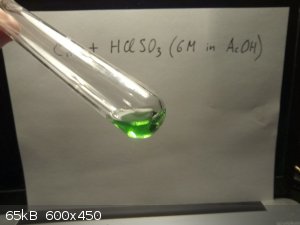
But the next day the fine green solid starts to separate.
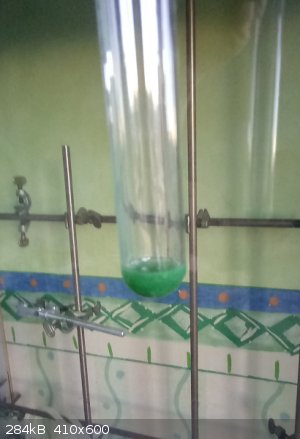
For reaction with Sn, I took 100% HClSO3 (not diluted with a solvent).
I took 5 g of Sn if forms of chunks and around 1 ml of HClSO3. I think the excess of Sn as well as having it in big lumps are essential for the
result.
Some old german author wrote that Sn in a form of foil or powder causes the reaction to be too exothermic and all SnCl4 is boiling off in such a case.
The reaction with chunks is not exothermic and not fast at all. In the beginning, there is a building of pressure so I used CaCl2 tube.
After several hours it forms 2 distinct layers. The lower one is very viscous and is opaque gray. Probably it contains some compound with long S
bonds. The upper layer is a very mobile clear liquid, probably almost pure SnCl4. (The same german author mentioned forming SnCl4 as a distinct upper
layer). I didn't check the chemical composition of the layers, so I can only suppose it.
On top of the upper layer, there is elemental sulfur powder - also the result of the reaction - which is floating.
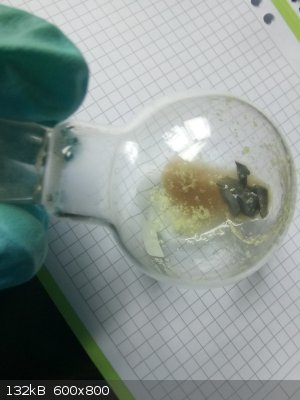
At this stage, the upper layer should be separated and purified. The addition of more acid was a not good idea - it reacts with elemental sulfur
forming, probably, S2Cl2 and layers composition starts to change, also some solid forms (SnCl2 / SnS?). So the result becomes a bit messy but I still
can observe SnCl4 (probably) but now as a lower layer - there is no viscous component anymore.
In another case, I did a reaction of Sn with HClSO3 in CH2Cl2. It creates a brown solution which separates clearly in several days forming an upper
clear layer of solution of SnCl4 in CH2Cl2 (my assumption) and H2SO4 + tar as a bottom oil.
So, I think extraction of the result by CH2Cl2 should also work in a case when the layers become mixed.
Some words of caution. HClSO3 is a dangerous compound. Not only because it burns everything it touches but also it can create fumes especially when
mixed with other liquids (one of the cases is irritating fumes when the acid contacts xylene - I use xylene as a washing liquid - probably it is not
HClSO3 but some other compound which is formed). This fuming of the HClSO3 solutions is insidious because it can cause serious lung irritation but the
next day only. There is only one noticable thing of contact - a sore throat. So, I suggest immediately stop any experiments with the acid / close all
the bottles, etc till the next day with the first symptoms of a sore throat - this way you can escape more serious irritation.
[Edited on 4-10-2021 by teodor]
|
|
|
woelen
Super Administrator
        
Posts: 7977
Registered: 20-8-2005
Location: Netherlands
Member Is Offline
Mood: interested
|
|
Interesting read! Especially your observation that HSO3Cl with AcOH gives a viscous liquid. I have done experiments with Ac2O and conc. H2SO4 and that
also creates a viscous liquid. If this viscous liquid is brought in contact with water, then an extremely violent reaction occurs, which does not
occur with Ac2O alone or H2SO4 alone. I think that the reaction of HSO3Cl and AcOH leads to the same compound (together with HCl, which escapes as
gas). SO3 (which remains after removal of HCl) and AcOH have the same effect as H2SO4 and Ac2O.
I'm not sure what this visccous compound is. It might be diacetyl sulfate.
|
|
|
teodor
National Hazard
   
Posts: 872
Registered: 28-6-2019
Location: Heerenveen
Member Is Offline
|
|
Thanks for the feedback. It interesting what it can be, just one note: Ac2O is a proven dehydration agent for making oleum (i.e. H2S2O7) from H2SO4. I
read it somewhere and today I have checked some publications about behaviors of RCOOH and (RCO)2O in H2SO. But they don't mention what happens with
the carboxylic acid, so it is a good point.
[Edit]
Based on the fact that chlorosulfonic acid reacts with NaOAc the same way as AcCl (giving off Ac2O) I suppose this imaginary equation could be
illustrative:
HO(SO2)Cl + 2AcOH -> Ac2O + HCl + H2SO4 -> 2AcOH + SO3 + HCl
Of course, it doesn't happen like that, but it suggests that the acetic acid (potentially) could play a catalytic role which leads to HClSO3
decomposition. Losing HCl (at high temperature) can drive the reaction to the right side.
[Edited on 4-10-2021 by teodor]
[Edited on 4-10-2021 by teodor]
[Edited on 4-10-2021 by teodor]
|
|
|
teodor
National Hazard
   
Posts: 872
Registered: 28-6-2019
Location: Heerenveen
Member Is Offline
|
|
This is a possible explanation about the viscosity (ordinary liquid AcOH forms dimer but in some circumstances, it turns to polymer).
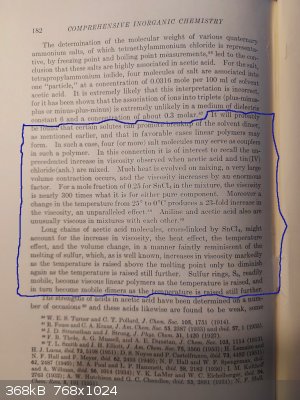
|
|
|
teodor
National Hazard
   
Posts: 872
Registered: 28-6-2019
Location: Heerenveen
Member Is Offline
|
|
Cobalt forms pink salt/solution and manganese gives white.
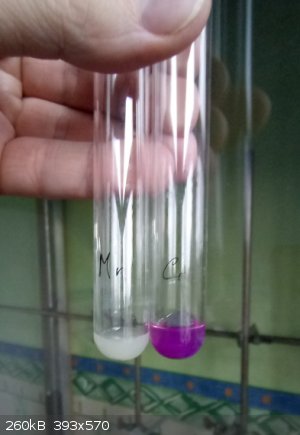
I found the information (just by googling) that anhydrous cobalt sulfate has a pink color.
Also, I noticed 2 interesting properties of 6M HClSO3 solution in acetic acid.
1. It doesn't make an explosion when dripped into water, just smoke. It is possible to wash glassware with water.
2. It doesn't burn the paper. In 3-5 mins it makes just a yellow stain. This stain is not wetted by water, it stays dry if I pour water on the paper.
|
|
|
woelen
Super Administrator
        
Posts: 7977
Registered: 20-8-2005
Location: Netherlands
Member Is Offline
Mood: interested
|
|
The manganese probably forms an anhydrous compound, probably MnSO4, which is very very pale pink, nearly white.
The color of the Co-salt is interesting. It most likely is not just anhydrous cobaltous sulfate. It looks too much like a combination of a chloride
and something else. I have done quite a few experiments with cobalt(II) in combination with chloride and the addition of chloride ligands besides
other ligands (e.g. water, or some organic) tends to make the color shift from pink/rose to blue/cyan. In-between mixes have exactly the color, shown
in your picture. A very instructive test is to dissolve some cobaltous sulfate in a little water and add 20% hydrochloric acid, drop by drop. At a
certain point, addition of drops and swirling the solution makes the color go from rose to purple and finally to bright blue with a somewhat cyan hue.
|
|
|
teodor
National Hazard
   
Posts: 872
Registered: 28-6-2019
Location: Heerenveen
Member Is Offline
|
|
I know that chlorosulfonic acid produces "chlorosulfonates" with alkali and alkali earth metals. I have no information about existence of other metals
chlorosulfonates, so I can assume also chloride or sulfate.
I didn't notice any pink tint in the manganese compound.
I tried reaction of CoCl2 * 6H2O in acetic acid with HClSO3. It this case chlorosulfonic acid worked as dehydration agent and the solution of
anhydrous CrCl2 was formed (the intense blue one). Probably I will try to add excess of the acid to that tube to see is it possible to replace
chloride ligands. Because chlorosulfonate anion is more "acidic" then chloride I can expect it should replace chloride if cobalt chlorosulfonate ever
exists. If it will be not the case, that the mixed compound of sulfate and chloride is what I've got with the reaction with the metal - in this case
both sulfate and chloride had a chance to occupy their space around Co.
When I will have more acid I will try to get more cobalt compound in quantity which is enough to quantitative analysis for chloride and sulfate ions.
By the way, I have no idea how to detect "chlorosulfonate ion" (but I remember some qualitative determination of chlorosulfonic acid with either
selenium or tellurium).
[Edited on 7-10-2021 by teodor]
There is probably some interesting story about how chlorosulfonic acid reacts with chromium (III) compounds when I tried to use it as a dehydration
agent. I noticed something unusual. Probably you also can test its action on CrCl3 * nH2O (I did experiments with chrome alum. It is not finished
yet).
[Edited on 7-10-2021 by teodor]
|
|
|
teodor
National Hazard
   
Posts: 872
Registered: 28-6-2019
Location: Heerenveen
Member Is Offline
|
|
This is just an illustration of the difference between the reaction of cobalt metal with 6M H2SO4 in AcOH (saturated with HCl, prepared by mixing 2.4
ml HClSO3 + 6.5 ml 96% H2SO4 and diluted to 25 ml with AcOH, left) and 6M HClSO3 in AcOH (right).
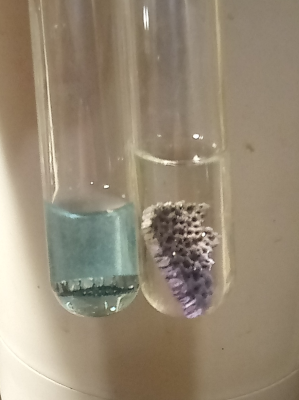
1. With 6M H2SO4 (+HCl) the reaction is more active with more bubbles. The solution becomes light blue.
2. With 6M HClSO3 the reaction is slower and the pink compound starts to deposit on the metal surface first.
Comparing to this the reaction of cobalt with 6M HClSO3 solution in dichloromethane (which is purified by additional procedure - I will describe it
later) doesn't proceed at all.
I see the close resemblance with aqua-free HCl (for example, liquid HCl doesn't react even with alkali metals). In the case of the absence of water
(as when HClSO3 is dissolved in dichloromethane) the metal is unable to replace hydrogen, this reaction requires water OR an oxidizer.
There are 2 possible ways how HClSO3 reacts with Co in acetic acid:
1) It can take water from the reaction:
2AcOH + HClSO3 = Ac2O + HCl + H2SO4
In this case we assume it doesn't result in chlorosulfonate. This hypothesis could be checked by Ac2O presence in the resulting mixture.
Because of the additional reaction with AcOH (which is already in slightly polymerized form), this reaction goes slower than that with 6M H2SO4 (+
HCl).
2) Co reduces sulfur in HClSO3, so HClSO3 works as an oxidation agent (which makes possible the reaction).
When I added water to the previous result of the reaction of Co with 6M HClSO3 in AcOH the water starts to convert the salt to (probably) anhydrous
chloride (!) first and only after all the salt is converted starts to dissolve the chloride (forming a pink water solution). The reaction of the
anhydrous compound with water is not fast even with mixing - the pink salt fragments just floating in water changing the color only on the surface.
Because the blu CoCl2 doesn't start to dissolve/react with water until there is a piece of anhydrous pink compound I can assume there is HClSO3
residue which actually reacts with water giving HCl which reacts with the compound. But this can be checked only by getting the pink compound in dry
form.
But after the water has dissolved all the compounds there is a lot of sulfur deposit in a form of white clouds + H2S smell. So, it proofs that HClSO3
works as an oxidizer (hypothesis 2). But hypothesis 1 is also not excluded completely because HClSO3 in dichloromethane doesn't act upon Co.
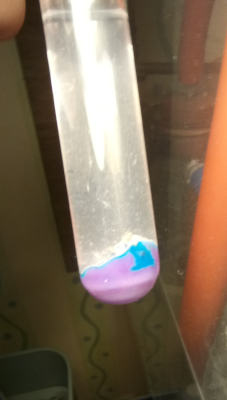
[Edited on 10-10-2021 by teodor]
|
|
|
woelen
Super Administrator
        
Posts: 7977
Registered: 20-8-2005
Location: Netherlands
Member Is Offline
Mood: interested
|
|
Interesting reactions, and also quite remarkable results. So, chlorosulfonic acid is not the most corrosive compound in all cases. Its oxidizing
properties and strongly dehydrating (desptroying any water) properties apparently make some reactions slower. Passivation of metal surfaces also may
occur and lead to reactions slowing down to a halt after an initial reaction in which the surface is covered.
|
|
|
teodor
National Hazard
   
Posts: 872
Registered: 28-6-2019
Location: Heerenveen
Member Is Offline
|
|
I didn't observe the passivation effect. It slowly eats the metals, even Cu, forming not a thin invisible protecting layer but a thick porous layer
(absolutely black in the case of Cu).
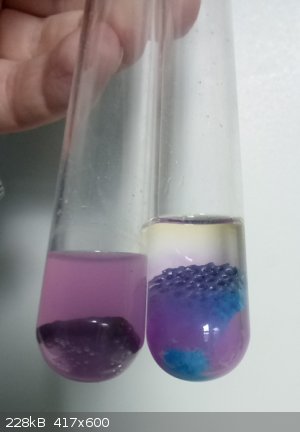
I did the photo of those 2 tubes as before.
As you see in the case of 6M HClSO3 (right) 2 distinct products are visible - probably they are chloride and sulfate. In the previous try, they
probably were mixed together.
The interesting process also was in the left tube (6M H2SO4 "boosted" with HClSO3).
After the period of initial H2 bubbling and forming anhydrous CoCl2 solution the reaction has ceased and switched to the cobalt sulfate route without
bubbling.
I can explain it this way. Until there were H3O(+) ions in the solution they were reacted with the metal:
2H3O(+) + Co -> H2 + 2H2O + Co(2+)
And H2O reacted with HClSO3 (which was unable to react with H3O(+) - my assumption).
H2O + HClSO3 -> HCl + H2SO4
And now
Co(2+) + 2HCl -> CoCl2 + 2H+
Of course, H+ doesn't exist, so it selects some other target to attach.
At some moment either H3O(+) ions or HCl molecules became exhausted and no more available. And the reaction was switched to H2SO4 route.
CoSO4 probably is soluble in H2SO4 but not soluble in HClSO3. That's why there are 2 layers in the second tube.
This is an interesting case of solubility, by the way. H2SO4 and HClSO3 have completely opposite solubilities in non-polar solvent - HClSO3 is soluble
and H2SO4 is not.
[Edited on 13-10-2021 by teodor]
|
|
|